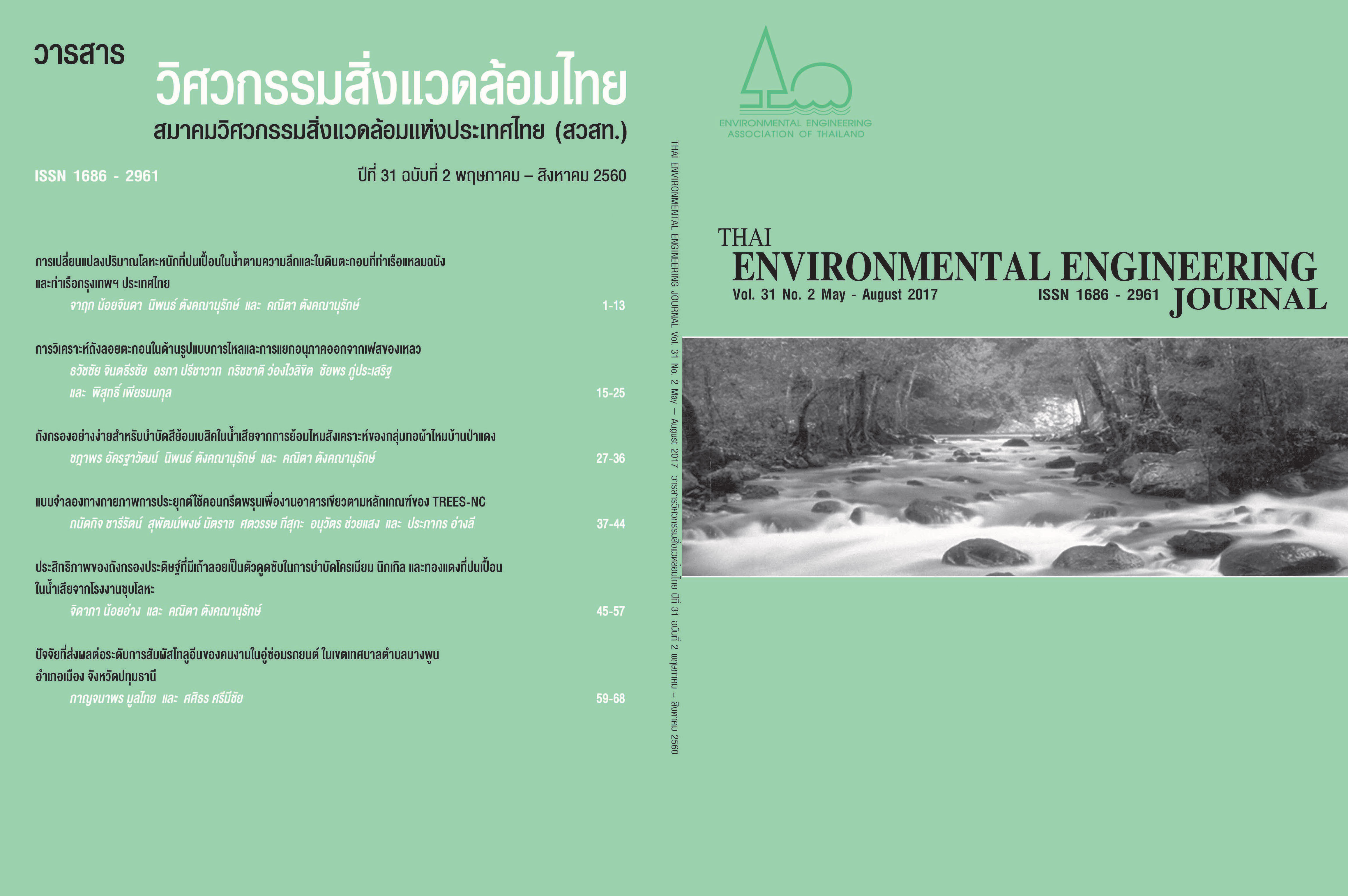Simple Filter Tank for Treatment of Basic Dyes in Synthetic Silk Dyeing Wastewater of Baan Pa Deang Textile Group
Main Article Content
Abstract
Discharge of wastewater contaminated with some amount of residual basic dyes was the aquatic environmental problem in many communities making synthetic silk dyeing. This research deals with the utilization of coal fly ash mixed with biomass as adsorbent packed in low-cost filter tank for removal of 10 basic dyes (orange, green, yellow, brown, red, mangosteen peel, pink, violet, blue and gray). Absorbent was consisted of fly ash, which is by-products from the combustion of coal, mixed with biomass at various ratio including 100:0, 90:10 and 70:30 namely Fly ash A, B and C respectively. Batch adsorption experiments were performed to find the optimal conditions. More than 95% of 10 basic dyes removal by adsorption process with each type of Fly ash A, B, C was achieved. The adsorption capacity of each Fly ash A, B and C for each dye was in range of 0.13-0.14 mg/g. Then the continuous flow experiments were made in the glass column (6cm.i.d x 40cm.h.) packing with 4 filter layers consisted of stone, coarse sand, find sand and Fly ash B or C with soil (1:20 by wt.) from top to bottom. Ten basic dyes were removed more than 95%. After that, the plastic filter tank packed with Fly ash B or C were made for the capacity of about 19.0 L. The removal efficiency of such both filter tanks was similar. The average removal efficiency of 10 basic synthetic dyes wastewater and synthetic silk dyeing wastewater of Baan Pa Deang Textile Group were more than 95%. In addition, the breakthrough points were 64 L. and 48 L. respectively; and the exhaustion points were 128 L. and 112 L. respectively. The developed filter tank was high efficiency, easily use and low-cost; that was suitable for synthetic silk dyeing group of removal contained 10 basic dyes from Baan Pa Deang Textile Group wastewater.
Article Details
References
[2] Kanittha. 2007. Dye. from: http://www.tpa. or.th/writer/read_this_book_topic.php?bookID=370&pageid=3&read=true&count=true, 28 January 2016. (in Thai)
[3] Kanittha. 2007. Type of dye. from: http:// www.tpa.or.th/writer/read_this_book_topic.php?bookID=370&pageid=6&read=true&count=true, 28 January 2016. (in Thai)
[4] Supattra Budsaereechai, Thitima Nikron sangkhaphinit, Sinsupa Kaewketkam, Atip Lanugphairojana and Yuvarat Ngernyen. 2016. The Use of Fly Ash to Remove Color of Wastewater from Pulp and Paper Industry by Adsorption. From: https://gsbooks.gs.kku. ac.th/59/ingrc2016/pdf/SDP1.pdf, 28 January 2016. (in Thai)
[5] Department of industrial works, Ministry of Industry. 1999. Environmental Management Manual of Dyeing Factory. Department of Environmental Technology, Bangkok. (in Thai)
[6] SCI ECO SERVICES Co., Ltd. 2016. Report of industrial waste disposal project that is not hazardous waste and electricity generating unit size 9.6 Megawatt. from: http://.onep. go.th/images/monitor/1517035667.pdf, 22 January 2017. (in Thai)
[7] Nipon Tungkananuruk and Kanita Tungka nanuruk. 2007. Principle of chemical water quality analysis. 1st edition. Kasetsart University Press, Bangkok. (in Thai)
[8] Worawut Matthayan, Sopa Visitsak and Joseph Khedari. 2010. Improvement of compressive strength for adobe block by using lime and palm oil ash. from: http:// rdi.ku.ac.th/kasetresearch54/GroupEconomic/43-Worawut_mat/template.html 28 January 2016. (in Thai)
[9] The Japan Institute of Energy. 2008. Biomass resources. from: http://www.jie.or. jp/biomass/AsiaBiomassHandbook/Thai/Part-2_T.pdf. 28 January 2016. (in Thai)
[10] Department of Alternative Energy Development and Efficiency. Ministry of Energy. 2015. Biomass energy. from: http://e-lib.dede.go.th/mm-data/Bib 15330.pdf, 28 January 2016. (in Thai)
[11] APHA, AWWA. and WEF. 2005. Standard Methods for the Examination of Water and Wastewater, 21st edition, American Public Health Association, Washington, DC.
[12] Pollution Control Department. Standard for the control of drainage from sources Industrial factory and industrial estate. (1996), from: http://www.pcd.go.th/info_ serv/ reg_std_water04.html, 28 January 2016. (in Thai)


